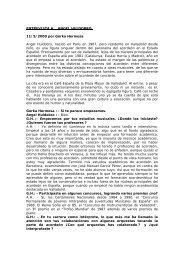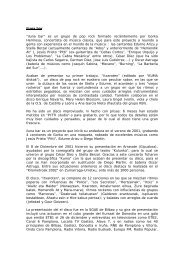The Accordion in the 19th Century - Gorka Hermosa
The Accordion in the 19th Century - Gorka Hermosa
The Accordion in the 19th Century - Gorka Hermosa
Create successful ePaper yourself
Turn your PDF publications into a flip-book with our unique Google optimized e-Paper software.
I.1- Appearance of <strong>the</strong> free reed <strong>in</strong>struments <strong>in</strong> Sou<strong>the</strong>ast Asia<br />
In spite of <strong>the</strong> fact that Sachs put forward an accurate orig<strong>in</strong> of free reed<br />
<strong>in</strong>struments (<strong>the</strong> Ch<strong>in</strong>ese tcheng, around 3.000 BC) musicologist Terry E. Miller argues<br />
that <strong>the</strong>re are not enough data to make such forceful assertion as <strong>the</strong> one by Sachs.<br />
Miller suggests a classification from which one can logically <strong>in</strong>fer a chronological order<br />
that clashes with <strong>the</strong> bibliography on this field, especially <strong>the</strong> one of <strong>the</strong> accordion: [61,<br />
62, 70, 170, 194, 202, 361]<br />
• Jaw harp from Sou<strong>the</strong>ast Asia 7 : We can state that <strong>the</strong>y are <strong>the</strong> simplest free<br />
reed <strong>in</strong>struments, and <strong>the</strong>refore, probably <strong>the</strong> oldest, of Palaeolithic orig<strong>in</strong> 8 . Accord<strong>in</strong>g<br />
to Miller, <strong>the</strong>y could be <strong>the</strong> ancestors of all <strong>the</strong> o<strong>the</strong>r free reed <strong>in</strong>struments, although<br />
<strong>the</strong>re is no documented evidence of <strong>the</strong>ir presence until <strong>the</strong> 4 th c. BC. <strong>in</strong> Ch<strong>in</strong>a, around<br />
<strong>the</strong> year 1 AD <strong>in</strong> <strong>the</strong> Roman France, 900 AD Japan... It is believed that <strong>the</strong>y were<br />
orig<strong>in</strong>ated <strong>in</strong> Sou<strong>the</strong>ast Asia, becom<strong>in</strong>g one of <strong>the</strong> essential forms <strong>the</strong> enggung from<br />
Bali, but some o<strong>the</strong>r samples have been found around <strong>the</strong> world, <strong>in</strong>clud<strong>in</strong>g, for example<br />
<strong>in</strong> pre-Columbian America. [18, 66, 77, 194, 199, 267, 285]<br />
Fig. 3a: Enggung Fig. 3b: Various guimbardes 9 .<br />
Guimbarde from Bali 10 .<br />
7 Besides jaw harp, this <strong>in</strong>strument is also known as mouth harp, jew's harp, gewgaw, aultrommel, kouk<strong>in</strong>, vargan, khomus,<br />
kumb<strong>in</strong>g, kub<strong>in</strong>g, scacciapensieri, munnharpe, genggong, dan mo, hun toong, angkuo, hoho, gue gueq, kub<strong>in</strong>g, guimbarda,<br />
guimbarde... <strong>the</strong> Dutch musicologist Phons Bakx has compiled over one thousand different names for this <strong>in</strong>strument <strong>in</strong><br />
http://www.antropodium.nl/Duizend Namen Mhp.htm [267]. Accord<strong>in</strong>g to Sachs, mouth harps are idiophones and can be classified<br />
<strong>in</strong>to two groups: Idioglot guimbardes (those <strong>in</strong> which <strong>the</strong> reed is made from a strip or plate -lamella- from <strong>the</strong> same piece of bamboo<br />
or wood that makes up <strong>the</strong> frame of <strong>the</strong> <strong>in</strong>strument; <strong>The</strong>y are <strong>the</strong> most primitive ones and can only produce a s<strong>in</strong>gle sound) and<br />
Heteroglot guimbardes or forged (<strong>the</strong>ir reed is made from a different piece, and attached to <strong>the</strong> frame; <strong>the</strong>ir <strong>in</strong>vention is subsequent<br />
to <strong>the</strong> idioglot and <strong>the</strong>y can produce more than one sound, mak<strong>in</strong>g feasible to produce a chromatic scale over a low sound which<br />
works as a pedal note). [267]<br />
8 Accord<strong>in</strong>g to John Wright and Geneviève Dourdon-Taurelle [77].<br />
9 Fig. taken from: http://www.patmiss<strong>in</strong>.com/history/guimbardes.html<br />
10 Fig. taken from: http://www.patmiss<strong>in</strong>.com/history/orig<strong>in</strong>s.html<br />
10




